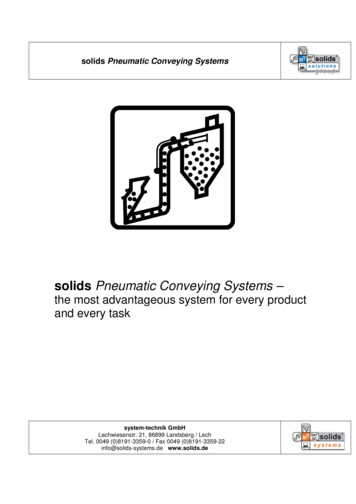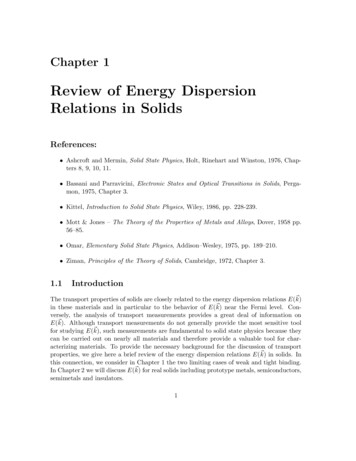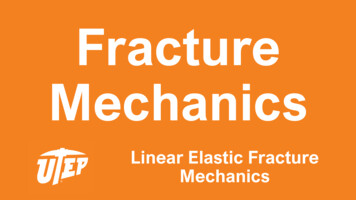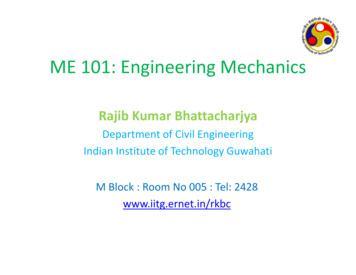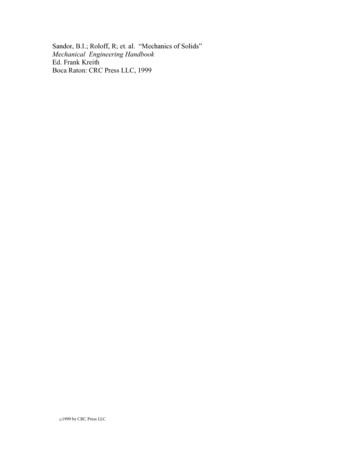
Transcription
Sandor, B.I.; Roloff, R; et. al. “Mechanics of Solids”Mechanical Engineering HandbookEd. Frank KreithBoca Raton: CRC Press LLC, 1999c1999 by CRC Press LLC
Mechanics of SolidsBela I. SandorUniversity of Wisconsin-Madison1.11.2Vectors. Equilibrium of Particles. Free-body Diagrams Forceson Rigid Bodies Equilibrium of Rigid Bodies Forces andMoments in Beams Simple Structures and Machines Distributed Forces Friction Work and Potential Energy Moments of InertiaRyan RoloffAllied Signal AerospaceStephen M. BirnAllied Signal AerospaceIntroduction .1-1Statics .1-31.3Maan H. JawadDynamics.1-31Kinematics of Particles Kinetics of Particles Kinetics ofSystems of Particles Kinematics of Rigid Bodies Kineticsof Rigid Bodies in Plane Motion Energy and MomentumMethods for Rigid Bodies in Plane Motion Kinetics of RigidBodies in Three DimensionsNooter Consulting ServicesMichael L. BrownA.O. Smith Corp.1.4Vibrations .1-57Undamped Free and Forced Vibrations Damped Free andForced Vibrations Vibration Control Random Vibrations.Shock Excitations Multiple-Degree-of-Freedom Systems.Modal Analysis Vibration-Measuring Instruments1.5Mechanics of Materials.1-67Stress Strain Mechanical Behaviors and Properties ofMaterials Uniaxial Elastic Deformations Stresses in Beams Deflections of Beams Torsion Statically IndeterminateMembers Buckling Impact Loading Combined Stresses Pressure Vessels Experimental Stress Analysis andMechanical Testing1.6Structural Integrity and Durability.1-104Finite Element Analysis. Stress Concentrations FractureMechanics Creep and Stress Relaxation Fatigue1.7Comprehensive Example of Using Mechanics of SolidsMethods .1-125The Project Concepts and Methods1.1 IntroductionBela I. SandorEngineers use the concepts and methods of mechanics of solids in designing and evaluating tools,machines, and structures, ranging from wrenches to cars to spacecraft. The required educational background for these includes courses in statics, dynamics, mechanics of materials, and related subjects. Forexample, dynamics of rigid bodies is needed in generalizing the spectrum of service loads on a car,which is essential in defining the vehicle’s deformations and long-term durability. In regard to structural 1999 by CRC Press LLC1-1
1-2Section 1FIGURE 1.1.1 Artist’s concept of a moving stainless steel roadway to drive the suspension system through aspinning, articulated wheel, simulating three-dimensional motions and forces. (MTS Systems Corp., Minneapolis,MN. With permission.) Notes: Flat-Trac Roadway Simulator, R&D100 Award-winning system in 1993. See alsoColor Plate 1.*integrity and durability, the designer should think not only about preventing the catastrophic failures ofproducts, but also of customer satisfaction. For example, a car with gradually loosening bolts (which isdifficult to prevent in a corrosive and thermal and mechanical cyclic loading environment) is a poorproduct because of safety, vibration, and noise problems. There are sophisticated methods to assure aproduct’s performance and reliability, as exemplified in Figure 1.1.1. A similar but even more realistictest setup is shown in Color Plate 1.*It is common experience among engineers that they have to review some old knowledge or learnsomething new, but what is needed at the moment is not at their fingertips. This chapter may help thereader in such a situation. Within the constraints of a single book on mechanical engineering, it providesoverviews of topics with modern perspectives, illustrations of typical applications, modeling to solveproblems quantitatively with realistic simplifications, equations and procedures, useful hints and reminders of common errors, trends of relevant material and mechanical system behaviors, and references toadditional information.The chapter is like an emergency toolbox. It includes a coherent assortment of basic tools, such asvector expressions useful for calculating bending stresses caused by a three-dimensional force systemon a shaft, and sophisticated methods, such as life prediction of components using fracture mechanicsand modern measurement techniques. In many cases much more information should be considered thanis covered in this chapter.*Color Plates 1 to 16 follow page 1-131.
1-3Mechanics of Solids1.2 StaticsBela I. SandorVectors. Equilibrium of Particles. Free-Body DiagramsTwo kinds of quantities are used in engineering mechanics. A scalar quantity has only magnitude (mass,time, temperature, ). A vector quantity has magnitude and direction (force, velocity, .). Vectors arerepresented here by arrows and bold-face symbols, and are used in analysis according to universallyapplicable rules that facilitate calculations in a variety of problems. The vector methods are indispensablein three-dimensional mechanics analyses, but in simple cases equivalent scalar calculations are sufficient.Vector Components and Resultants. Parallelogram LawA given vector F may be replaced by two or three other vectors that have the same net effect andrepresentation. This is illustrated for the chosen directions m and n for the components of F in twodimensions (Figure 1.2.1). Conversely, two concurrent vectors F and P of the same units may becombined to get a resultant R (Figure 1.2.2).FIGURE 1.2.1 Addition of concurrent vectors F and P.FIGURE 1.2.2 Addition of concurrent, coplanarvectors A, B, and C.Any set of components of a vector F must satisfy the parallelogram law. According to Figure 1.2.1,the law of sines and law of cosines may be useful.FnFF m sin α sin β sin 180 (α β)[][(1.2.1)]F 2 Fn2 Fm2 2 Fn Fm cos 180 (α β)Any number of concurrent vectors may be summed, mathematically or graphically, and in any order,using the above concepts as illustrated in Figure 1.2.3.FIGURE 1.2.3 Addition of concurrent, coplanar vectorsA, B, and C.
1-4Section 1Unit VectorsMathematical manipulations of vectors are greatly facilitated by the use of unit vectors. A unit vectorn has a magnitude of unity and a defined direction. The most useful of these are the unit coordinatevectors i, j, and k as shown in Figure 1.2.4.FIGURE 1.2.4 Unit vectors in Cartesian coordinates (the same i, j,and k set applies in a parallel x′y′z′ system of axes).The three-dimensional components and associated quantities of a vector F are shown in Figure 1.2.5.The unit vector n is collinear with F.FIGURE 1.2.5 Three-dimensional components of a vector F.The vector F is written in terms of its scalar components and the unit coordinate vectors,F Fx i Fy j Fz k Fn(1.2.2)whereFx F cos θ xFy F cos θ yFz F cos θ zF Fx2 Fy2 Fz2n x cos θ xn y cos θ ynz cos θ zn x2 n y2 nz2 1n x n y nz1 Fx Fy Fz FThe unit vector notation is convenient for the summation of concurrent vectors in terms of scalar orvector components:Scalar components of the resultant R:Rx FxRy FyRz Fz(1.2.3)
1-5Mechanics of SolidsVector components:Rx F F ixRy x F F jyRz y F F kzz(1.2.4)Vector Determination from Scalar InformationA force, for example, may be given in terms of its magnitude F, its sense of direction, and its line ofaction. Such a force can be expressed in vector form using the coordinates of any two points on its lineof action. The vector sought isF Fx i Fy j Fz k FnThe method is to find n on the line of points A(x1, y1, z1) and B(x2, y2, z2):n d x i d y j dz kvector A to B distance A to Bd x2 d y2 d z2where dx x2 – x1, dy y2 – y1, dz z2 – z1.Scalar Product of Two Vectors. Angles and Projections of VectorsThe scalar product, or dot product, of two concurrent vectors A and B is defined byA B ABcosφ(1.2.5)where A and B are the magnitudes of the vectors and φ is the angle between them. Some useful expressionsareA B B A Ax Bx Ay By Az Bzφ arccosAx Bx Ay By Az BzABThe projection F′ of a vector F on an arbitrary line of interest is determined by placing a unit vectorn on that line of interest, so thatF ′ F n Fx n x Fy n y Fz nzEquilibrium of a ParticleA particle is in equilibrium when the resultant of all forces acting on it is zero. In such cases thealgebraic summation of rectangular scalar components of forces is valid and convenient: F 0 F 0 F 0xyz(1.2.6)Free-Body DiagramsUnknown forces may be determined readily if a body is in equilibrium and can be modeled as a particle.The method involves free-body diagrams, which are simple representations of the actual bodies. Theappropriate model is imagined to be isolated from all other bodies, with the significant effects of otherbodies shown as force vectors on the free-body diagram.
1-6Section 1Example 1A mast has three guy wires. The initial tension in each wire is planned to be 200 lb. Determine whetherthis is feasible to hold the mast vertical (Figure 1.2.6).FIGURE 1.2.6 A mast with guy wires.Solution.R TAB TAC TADThe three tensions of known magnitude (200 lb) must be written as vectors.TAB (tension AB)( unit vector A to B) 200 lb n AB 200 lb200 lb 5 10 42TAC 22( 5i 10 j 4k)( d i d j d k)xyzdft 84.2 lb i 168.4 lb j 67.4 lb kft200 lb(5i 10 j 4k) ft 84.2 lb i 168.4 lb j 67.4 lb k11.87 ftTAD 200 lb(0i 10 j 6k) ft 171.5 lb j 102.9 lb k11.66 ftThe resultant of the three tensions isR F i F j F k ( 84.2 84.2 0) lb i ( 168.4 168.4 171.5) lb jxyz (67.4 67.4 102.9) lb k 0 lb i 508 lb j 31.9 lb kThere is a horizontal resultant of 31.9 lb at A, so the mast would not remain vertical.Forces on Rigid BodiesAll solid materials deform when forces are applied to them, but often it is reasonable to model componentsand structures as rigid bodies, at least in the early part of the analysis. The forces on a rigid body aregenerally not concurrent at the center of mass of the body, which cannot be modeled as a particle if theforce system tends to cause a rotation of the body.
1-7Mechanics of SolidsMoment of a ForceThe turning effect of a force on a body is called the moment of the force, or torque. The moment MAof a force F about a point A is defined as a scalar quantityM A Fd(1.2.7)where d (the moment arm or lever arm) is the nearest distance from A to the line of action of F. Thisnearest distance may be difficult to determine in a three-dimensional scalar analysis; a vector methodis needed in that case.Equivalent ForcesSometimes the equivalence of two forces must be established for simplifying the solution of a problem.The necessary and sufficient conditions for the equivalence of forces F and F′ are that they have thesame magnitude, direction, line of action, and moment on a given rigid body in static equilibrium. Thus,F F ′ andM A M A′For example, the ball joint A in Figure 1.2.7 experiences the same moment whether the vertical forceis pushing or pulling downward on the yoke pin.FIGURE 1.2.7 Schematic of testing a ball joint of a car.Vector Product of Two VectorsA powerful method of vector mechanics is available for solving complex problems, such as the momentof a force in three dimensions. The vector product (or cross product) of two concurrent vectors A andB is defined as the vector V A B with the following properties:1.2.3.4.5.V is perpendicular to the plane of vectors A and B.The sense of V is given by the right-hand rule (Figure 1.2.8).The magnitude of V is V AB sinθ, where θ is the angle between A and B.A B B A, but A B –(B A).For three vectors, A (B C) A B A C.FIGURE 1.2.8 Right-hand rule for vector products.
1-8Section 1The vector product is calculated using a determinant,iV AxBxjAyBykAz Ay Bz i Az Bx j Ax By k Ay Bx k Ax Bz j Az By iBz(1.2.8)Moment of a Force about a PointThe vector product is very useful in determining the moment of a force F about an arbitrary point O.The vector definition of moment isMO r F(1.2.9)where r is the position vector from point O to any point on the line of action of F. A double arrow isoften used to denote a moment vector in graphics.The moment MO may have three scalar components, Mx, My , Mz, which represent the turning effectof the force F about the corresponding coordinate axes. In other words, a single force has only onemoment about a given point, but this moment may have up to three components with respect to acoordinate system,M O M x i M y j Mz kTriple Products of Three VectorsTwo kinds of products of three vectors are used in engineering mechanics. The mixed triple product (orscalar product) is used in calculating moments. It is the dot product of vector A with the vector productof vectors B and C,AxA (B C) BxCxAyByCyAzBz Ax By Cz Bz Cy Ay ( Bz Cx Bx Cz ) Az Bx Cy By CxCz()()(1.2.10)The vector triple product (A B) C V C is easily calculated (for use in dynamics), but note that(A B) C A (B C)Moment of a Force about a LineIt is common that a body rotates about an axis. In that case the moment M, of a force F about the axis,say line ,, is usefully expressed asnxM l n M O n (r F) rxFxnyryFynzrzFz(1.2.11)where n is a unit vector along the line ,, and r is a position vector from point O on , to a point on theline of action of F. Note that M, is the projection of MO on line ,.
1-9Mechanics of SolidsSpecial Cases1. The moment about a line , is zero when the line of action of F intersects , (the moment arm iszero).2. The moment about a line , is zero when the line of action of F is parallel to , (the projection ofMO on , is zero).Moment of a CoupleA pair of forces equal in magnitude, parallel in lines of action, and opposite in direction is called acouple. The magnitude of the moment of a couple isM Fdwhere d is the distance between the lines of action of the forces of magnitude F. The moment of a coupleis a free vector M that can be applied anywhere to a rigid body with the same turning effect, as longas the direction and magnitude of M are the same. In other words, a couple vector can be moved to anyother location on a given rigid body if it remains parallel to its original position (equivalent couples).Sometimes a curled arrow in the plane of the two forces is used to denote a couple, instead of the couplevector M, which is perpendicular to the plane of the two forces.Force-Couple TransformationsSometimes it is advantageous to transform a force to a force system acting at another point, or viceversa. The method is illustrated in Figure 1.2.9.FIGURE 1.2.9 Force-couple transformations.1. A force F acting at B on a rigid body can be replaced by the same force F acting at A and amoment MA r F about A.2. A force F and moment MA acting at A can be replaced by a force F acting at B for the same totaleffect on the rigid body.Simplification of Force SystemsAny force system on a rigid body can be reduced to an equivalent system of a resultant force R and aresultant moment MR. The equivalent force-couple system is formally stated asnR Finand M R i 1n M (r F )ii 1iii 1where MR depends on the chosen reference point.Common Cases1.2.3.4.The resultant force is zero, but there is a resultant moment: R 0, MR 0.Concurrent forces (all forces act at one point): R 0, MR 0.Coplanar forces: R 0, MR 0. MR is perpendicular to the plane of the forces.Parallel forces: R 0, MR 0. MR is perpendicular to R.(1.2.12)
1-10Section 1Example 2The torque wrench in Figure 1.2.10 has an arm of constant length L but a variable socket length d OA because of interchangeable tool sizes. Determine how the moment applied at point O depends onthe length d for a constant force F from the hand.FIGURE 1.2.10 Model of a torque wrench.Solution. Using MO r F with r Li dj and F Fk in Figure 1.2.10,M O ( Li dj) Fk Fdi FLjJudgment of the ResultAccording to a visual analysis the wrench should turn clockwise, so the –j component of the momentis justified. Looking at the wrench from the positive x direction, point A has a tendency to rotatecounterclockwise. Thus, the i component is correct using the right-hand rule.Equilibrium of Rigid BodiesThe concept of equilibrium is used for determining unknown forces and moments of forces that act onor within a rigid body or system of rigid bodies. The equations of equilibrium are the most usefulequations in the area of statics, and they are also important in dynamics and mechanics of materials.The drawing of appropriate free-body diagrams is essential for the application of these equations.Conditions of EquilibriumA rigid body is in static equilibrium when the equivalent force-couple system of the external forcesacting on it is zero. In vector notation, this condition is expressed as F 0 M (r F) 0(1.2.13)Owhere O is an arbitrary point of reference.In practice it is often most convenient to write Equation 1.2.13 in terms of rectangular scalar components, F 0 M F 0 M F 0 Mxx 0yy 0zz 0
1-11Mechanics of SolidsMaximum Number of Independent Equations for One Body1. One-dimensional problem: F 02. Two-dimensional problem: F 0 F 0 M 0 F 0 M 0 M 0 M 0 M 0 M 0xororyxAAA( x axis not AB)BB( AB not \ BC)C3. Three-dimensional problem: F 0 F 0 F 0 M 0 M 0 M 0xyxzyzwhere xyz are orthogonal coordinate axes, and A, B, C are particular points of reference.Calculation of Unknown Forces and MomentsIn solving for unknown forces and moments, always draw the free-body diagram first. Unknown externalforces and moments must be shown at the appropriate places of action on the diagram. The directionsof unknowns may be assumed arbitrarily, but should be done consistently for systems of rigid bodies.A negative answer indicates that the initial assumption of the direction was opposite to the actualdirection. Modeling for problem solving is illustrated in Figures 1.2.11 and 1.2.12.FIGURE 1.2.11 Example of two-dimensional modeling.FIGURE 1.2.12 Example of three-dimensional modeling.Notes on Three-Dimensional Forces and SupportsEach case should be analyzed carefully. Sometimes a particular force or moment is possible in a device,but it must be neglected for most practical purposes. For example, a very short sleeve bearing cannot
1-12Section 1support significant moments. A roller bearing may be designed to carry much larger loads perpendicularto the shaft than along the shaft.Related Free-Body DiagramsWhen two or more bodies are in contact, separate free-body diagrams may be drawn for each body. Themutual forces and moments between the bodies are related according to Newton’s third law (action andreaction). The directions of unknown forces and moments may be arbitrarily assumed in one diagram,but these initial choices affect the directions of unknowns in all other related diagrams. The number ofunknowns and of usable equilibrium equations both increase with the number of related free-bodydiagrams.Schematic Example in Two Dimensions (Figure 1.2.13)FIGURE 1.2.13 Free-body diagram.Given: F1, F2, F3, MUnknowns: P1, P2, P3, and forces and moments at joint A (rigid connection)Equilibrium Equations F F P 0 F P P F F 0 M P c P (c d e) M F a F ( a b ) 0x1y1O3212322Three unknowns (P1, P2, P3) are in three equations.Related Free-Body Diagrams (Figure 1.2.14)FIGURE 1.2.14 Related free-body diagrams.Dimensions a, b, c, d, and e of Figure 1.2.13 are also valid here.3
1-13Mechanics of SolidsNew Set of Equilibrium EquationsLeft part:(OA) F F Ax1x 0 F P A F 0y MRight side:( AB)1Oy2 P1c Ay (c d ) M A F2 a 0 F Axx P3 0 F P A F 0 M M P e M F f 0y2AyA323Six unknowns (P1, P2, P3, Ax, Ay , MA) are in six equations.Note: In the first diagram (Figure 1.2.13) the couple M may be moved anywhere from O to B. M isnot shown in the second diagram (O to A) because it is shown in the third diagram (in which it may bemoved anywhere from A to B).Example 3The arm of a factory robot is modeled as three bars (Figure 1.2.15) with coordinates A: (0.6, –0.3, 0.4)m; B: (1, –0.2, 0) m; and C: (0.9, 0.1, –0.25) m. The weight of the arm is represented by WA –60 Njat A, and WB –40 Nj at B. A moment MC (100i – 20j 50k) N · m is applied to the arm at C.Determine the force and moment reactions at O, assuming that all joints are temporarily fixed.FIGURE 1.2.15 Model of a factory robot.Solution. The free-body diagram is drawn in Figure 1.2.15b, showing the unknown force and momentreactions at O. From Equation 1.2.13, F 0FO WA WB 0FO 60 N j 40 N j 0
1-14Section 1FO 100 N j MO 0M O M C (rOA WA ) (rOB WB ) 0M O (100i 20 j 50k) N m (0.6i 0.3 j 0.4k) m ( 60 N j) (i 0.2 j) m ( 40 N j) 0M O 100 N m i 20 N m j 50 N m k 36 N m k 24 N m i 40 N m k 0M O ( 124i 20 j 26k) N mExample 4A load of 7 kN may be placed anywhere within A and B in the trailer of negligible weight. Determinethe reactions at the wheels at D, E, and F, and the force on the hitch H that is mounted on the car, forthe extreme positions A and B of the load. The mass of the car is 1500 kg, and its weight is acting atC (see Figure 1.2.16).FIGURE 1.2.16 Analysis of a car with trailer.Solution. The scalar method is best here.Put the load at position A firstFor the trailer alone, with y as the vertical axis MF 7(1) – Hy(3) 0, Hy 2.33 kNOn the carHy 2.33 kN Ans. Fy 2.33 – 7 Fy 0, Fy 4.67 kN Ans.For the car alone ME –2.33(1.2) – Dy(4) 14.72(1.8) 0Dy 5.93 kN Ans. Fy 5.93 Ey – 14.72 – 2.33 0Ey 11.12 kN Ans.Put the load at position B nextFor the trailer alone MF 0.8(7) – Hy(3) 0, Hy –1.87 kNOn the carHy 1.87 kN Ans. Fy –1.87 – 7 Ey 0Ey 8.87 kN Ans.For the car alone ME –(1.87)(1.2) – Dy(4) 14.72(1.8) 0Dy 7.19 kN Ans. Fy 7.19 Ey – 14.72 – (–1.87) 0Ey 5.66 kN Ans.Forces and Moments in BeamsBeams are common structural members whose main function is to resist bending. The geometric changesand safety aspects of beams are analyzed by first assuming that they are rigid. The preceding sectionsenable one to determine (1) the external (supporting) reactions acting on a statically determinate beam,and (2) the internal forces and moments at any cross section in a beam.
Mechanics of Solids1-15Classification of SupportsCommon supports and external reactions for two-dimensional loading of beams are shown in Figure1.2.17.FIGURE 1.2.17 Common beam supports.Internal Forces and MomentsThe internal force and moment reactions in a beam caused by external loading must be determined forevaluating the strength of the beam. If there is no torsion of the beam, three kinds of internal reactionsare possible: a horizontal normal force H on a cross section, vertical (transverse) shear force V, andbending moment M. These reactions are calculated from the equilibrium equations applied to the leftor right part of the beam from the cross section considered. The process involves free-body diagramsof the beam and a consistently applied system of signs. The modeling is illustrated for a cantilever beamin Figure 1.2.18.FIGURE 1.2.18 Internal forces and moments in a cantilever beam.Sign Conventions. Consistent sign conventions should be used in any given problem. These could bearbitrarily set up, but the following is slightly advantageous. It makes the signs of the answers to theequilibrium equations correct for the directions of the shear force and bending moment.A moment that makes a beam concave upward is taken as positive. Thus, a clockwise moment ispositive on the left side of a section, and a counterclockwise moment is positive on the right side. A
1-16Section 1shear force that acts upward on the left side of a section, or downward on the right side, is positive(Figure 1.2.19).FIGURE 1.2.19 Preferred sign conventions.Shear Force and Bending Moment DiagramsThe critical locations in a beam are determined from shear force and bending moment diagrams for thewhole length of the beam. The construction of these diagrams is facilitated by following the stepsillustrated for a cantilever beam in Figure 1.2.20.FIGURE 1.2.20 Construction of shear force and bending moment diagrams.1. Draw the free-body diagram of the whole beam and determine all reactions at the supports.2. Draw the coordinate axes for the shear force (V) and bending moment (M) diagrams directlybelow the free-body diagram.3. Immediately plot those values of V and M that can be determined by inspection (especially wherethey are zero), observing the sign conventions.4. Calculate and plot as many additional values of V and M as are necessary for drawing reasonablyaccurate curves through the plotted points, or do it all by computer.Example 5A construction crane is modeled as a rigid bar AC which supports the boom by a pin at B and wire CD.The dimensions are AB 10,, BC 2,, BD DE 4,. Draw the shear force and bending momentdiagrams for bar AC (Figure 1.2.21).Solution. From the free-body diagram of the entire crane, F 0 F 0 MAx 0 P Ay 0 P(8l) M A 0Ay PM A 8PlxyA 0
1-17Mechanics of SolidsFIGURE 1.2.21 Shear force and bending moment diagrams of a component in a structure.Now separate bar AC and determine the forces at B and C. F 0 F 0 M Bx TCDx 0P By TCDy 0 x(a ) Bx y2T5 CD( b) By P 1T5 CD A 02T (12l) Bx (10l) M A 05 CD24l20lT T 8Pl5 CD5 CD(c) TCD 8 5P 2 5P4From (a) and (c), Bx 4P and TCDx 4P. From (b) and (c), By P – 2P –P and TCDy 2P.Draw the free-body diagram of bar AC horizontally, with the shear force and bending moment diagramaxes below it. Measure x from end C for convenience and analyze sections 0 x 2, and 2, x 12,(Figures 1.2.21b to 1.2.21f).1. 0 x 2, F 0 M 4 P VK1 0M K1 4 P( x ) 0VK1 4 PM K1 4 Pxy2. 2, x 12,K 0
1-18Section 1 F 0 M4 P 4 P VK2 0M K2 4 P( x 2l) 4 P( x ) 0VK2 0M K2 8PlyK 0At point B, x 2,, M K1 –4P(2,) –8P, M K2 MA. The results for section AB, 2, x 12,, showthat the combined effect of the forces at B and C is to produce a couple of magnitude 8P, on the beam.Hence, the shear force is zero and the moment is constant in this section. These results are plotted onthe axes below the free-body diagram of bar A-B-C.Simple Structures and MachinesRyan Roloff and Bela I. SandorEquilibrium equations are used to determine forces and moments acting on statically determinate simplestructures and machines. A simple structure is composed solely of two-force members. A machine iscomposed of multiforce members. The method of joints and the method of sections are commonly usedin such analysis.TrussesTrusses consist of straight, slender members whose ends are connected at joints. Two-dimensional planetrusses carry loads acting in their planes and are often connected to form three-dimensional space trusses.Two typical trusses are shown in Figure 1.2.22.FIGURE 1.2.22 Schematic examples of trusses.To simplify the analysis of trusses, assume frictionless pin connections at the joints. Thus, all membersare two-force members with forces (and no moments) acting at the joints. Members may be assumedweightless or may have their weights evenly divided to the joints.Method of JointsEquilibrium equations based on the entire truss and its joints allow for determination of all internalforces and external reactions at the joints using the following procedure.1. Determine the support reactions of the truss. This is done using force and moment equilibriumequations and a free-body diagram of the entire truss.2. Select any arbitrary joint where only one or two unknown forces act. Draw the free-body diagramof the joint assuming unknown forces are tensions (arrows directed away from the joint).3. Draw free-body diagrams for the other joints to be analyzed, using Newton’s third law consistentlywith respect to the first diagram.4. Write the equations of equilibrium, Fx 0 and Fy 0, for the forces acting at the joints andsolve them. To simplify calculations, attempt to progress from joint to joint in such a way thateach equation contains only one unknown. Positive answers indicate that the assumed directionsof unknown forces were correct, and vice versa.Example 6Use the method of joints to determine the forces acting at A, B, C, H, and I of the truss in Figure 1.2.23a.The angles are α 56.3 , β 38.7 , φ 39.8 , and θ 36.9 .
1-19Mechanics of SolidsFIGURE 1.2.23 Method of joints in analyzing a truss.Solution. First the reactions at the supports are determined and are shown in Figure 1.2.23b. A joint atwhich only two unknown forces act is the best starting point for the solution. Choosing joint A, thesolution is progressively developed, always seeking the next joint with only two unknowns. In eachdiagram circles indicate the quantities that are known from the preceding analysis. Sample calculationsshow the approach and some of the results.Joint A: F 0 F 0FAI 0FAB Ay 0xyFAB 50 kips 0FAB 50 kips (tension)Joint H: F 0x F 0yFGH sin β FCH cos α FBH 0FCH sin α FDH FGH cos β FHI 0FGH (0.625) (60.1 kips) (0.555) 0 0 (60.1 kips) (0.832) FDH (53.4 kips) (0.780) 70 kips 0FGH 53.4 kips (compression)FDH 21.7 kips (tension)Method of SectionsThe method of sections is useful when only a few forces in truss members need to be determinedregardless of the size and complexity of the entire truss structure. This method employs any section ofthe truss as a free body in equilibrium. The chosen sect
Sandor, B.I.; Roloff, R; et. al. “Mechanics of Solids” Mechanical Engineering Handbook Ed. Frank K

